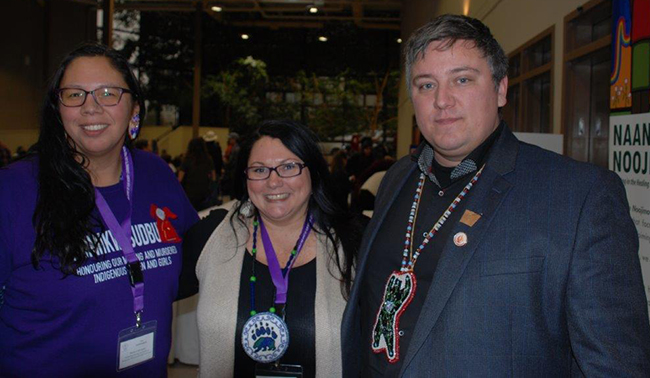Seeds & Roots: Author sees hope amid the tears of MMIWG

By Laura E. Young
SUDBURY – The author of a book about murdered Indigenous women believes the tide is turning now to stop violence in future generations.
“It’s going to take generations. We’re not going to stop the violence right now. That’s not going to happen. But we’re planting the seeds,” said Katherine McCarthy, author of Invisible Victims: Missing and Murdered Indigenous Women in Canada.
McCarthy was a keynote speaker at the Honouring Missing and Murdered Indigenous Women and Girls Conference, November 29-30 in Sudbury.
The conference is part of a larger project designed to prevent violence in the Indigenous community. The project is a partnership between the Greater Sudbury Police Services and N’Swakamok Native Friendship Centre.
“I am very glad for this conference. This police agency is very progressive in what they’re doing. I’ve never heard of it outside of Sudbury. So this is ground-breaking,” she said.
“I’m very excited to learn what I can here and to go back to my community and share,” she said the Newfoundland-based author, who is of Mi’kmaq and Irish heritage.
It helps Indigenous people heal when they reignite their culture and spirituality, she said.
“There are studies now that trauma travels through DNA. At the same time good experiences and healthy experiences travel through DNA as well,” she said.
“There’s definitely a healthy body, a healthy mind, and the reverse as well. It’s a holistic view of your well-being. There are all different facets to well-being,” she said.
Two stories in particular caught McCarthy’s attention.
First, there was the murder of Loretta Saunders, in 2014. Saunders was an Inuk from Labrador, McCarthy’s home province, and McCarthy noted that Saunders had been studying, ironically, murdered Indigenous women.
A few months later, McCarthy learned of the death of Tina Fontaine, 15, of Manitoba.
“All the media started picking up the stories. That was the breaking point for me,” McCarthy said.
She is a book cover artist. Her publisher had an idea to do a crimes Canada series and asked McCarthy what the major crimes were in the country. She explained the MMWI crisis and was asked to write it.
“I was honoured. It went from there. Every murder, every woman deserves her own book,” she said.
She stuck with the difficult topic, despite the sadness and anger it produced. She sought help from Elders in her home community to cope so she could write. She is not an activist but felt this was her way of helping.
As well, she attended a Sisters in Spirit vigil.
“If you’re an empathetic person at all and you go to one of those vigils; and when you’re hugging a family member who has lost someone and you have to wipe their tears off your face, nothing is going to stop you from doing what you can to help.”
There is a difference between murders and Indigenous women who are murdered for McCarthy.
Indigenous women being the most victimized in Canadian society, she said.
In 2009, a Canadian government survey stated that the women are three times as likely to report being a victim of crime than non-Aboriginal women; and they are seven times as likely to be murdered.
“It all stems from hundreds of years of marginalization and colonization. That’s what a big chunk of my book focuses on. How did women go from being the most revered in Indigenous society to the most victimized in Canadian society?”
Serial killers select Indigenous women specifically, she added. “They know who to target. Because these Indigenous murders weren’t showing up in the news, they (the killers) knew where to go.”
McCarthy manages Aeternum Designs, a graphic design company, in Newfoundland.


